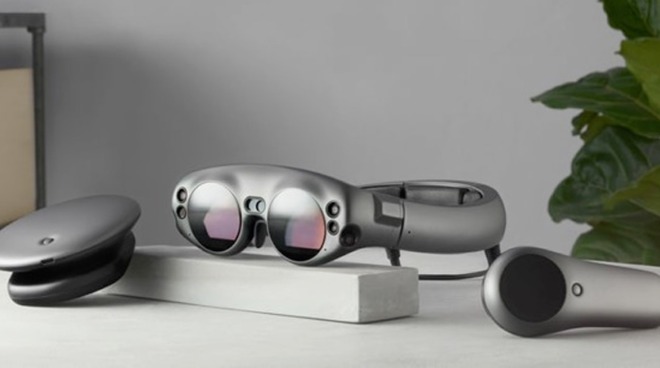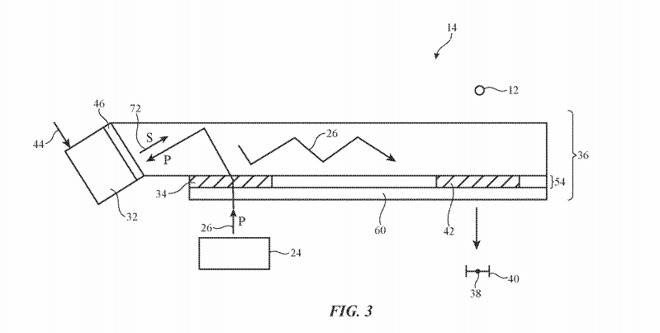Apple is working on more ideas it could implement in its long-rumored virtual reality headset or augmented reality smart glasses, including a display technology using lasers to create an image in the user's eye, along with magnet-laden gloves to give users finger-level control in the virtual world.

The Magic Leap One Lightwear AR goggles, an example of a headset.
The rumors of Apple creating a form of VR or AR hardware have been around for a while, but while there has yet to be any publicly-accessible elements, aside from the implementation of ARKit for iOS devices and a demonstration of VR content rendered on a Mac, there is still evidence Apple is considering bringing a headset or system that departs considerably from what is available on the market.
In a patent application published by the U.S. Patent and Trademark Office on Thursday titled "Scanning Mirror Display Devices," Apple envisions replacing the usual display panel within a VR headset with an alternate system involving lasers and mirrors.
Apple proposes the use of a laser light source that emits onto a waveguide, which can be diffracted and passed through to a mirror element within a scanning mirror system. A waveplate could change the polarization of the light as well, with the phasegrating potentially able to be set up to be polarization sensitive, preventing polarized light from being diffracted.
There is also the possibility of using a reflective polarizer interposed between the phasegrating and the waveguide to perform a similar function of switching between unfettered and diffracted light.

An illustration of how the light source could interact with other elements before being passed to the user's vision
Control circuitry can adjust the color of light emitted by the light source, while simultaneously controlling the two-dimensional scanning of the mirror element, which reflects light along a waveguide to an output coupler. This coupler then directs the light to an eye box, which the user looks into.
In short, lasers or other types of light will be reflected by a mirror into the user's eye to create an image.
The output coupler could be made transparent, which would be useful for AR applications, as it would allow users a view of the real world and for the light to produce an overlay image.
In a second patent application titled "Magnetic Sensor Based Proximity Sensing," Apple returns to the familiar concept of glove-based interactions with device. It is claimed magnetic sensing can be used to detect changes and disturbances in magnetic fields to measure the price location and positioning of a magnetic source, or the relative position of the sensor to said source.
For the purposes of input gloves, this effectively takes the form of a central magnetic source near the middle of the user's hand, and sensors at the end of each of the fingertips.
Using electromagnetic coils to generate a magnetic field with a specific modulation, which is then demodulated by the magnetic sensors. The amplitude of the magnetic field after demodulation can be used to find the distance between the source and sensor, and by using multiple magnetic sources, this can allow for 3D positioning of the sensor to be determined.
A simplified version of the gloves, with a magnetic source in the middle, fingertip sensors, and the host device
For the glove, this could mean two separated magnetic sources across the back of the glove, or even adding a third in the palm of the hand to add an extra level of depth. By using inverse kinematics, the orientation, position, and angle of finger bones, as well as the tip, can be worked out.
It is reasoned the glove could also include a variety of other electronic components, including force touch sensors, actuators for haptic feedback, temperature sensors, and heaters, as well as communication systems and a battery.
Apple files numerous patent applications on a weekly bases, though while there is no guarantee that the concepts described will appear in a future product or service, it does at least show areas of interest for the company's research and development efforts.
In the case of the gloves, Apple has a patent covering force-sensing garments, such as gloves that could provide a host device with data on how hard a user is pressing or gripping an item with multiple parts of a hand.
Another application in February suggested adding finger clamps that lightly squeezed the fingertips from the sides while typing. The idea is that the fingerpad would be forced out towards the surface more, cushioning the impact of a press or typing on a display, and giving a sense of haptic feedback.
For a headset, Apple has a wide variety of different patents and application filings relating to the display and other components used in its construction. In the case of the screen components, a "Foveated Display" can minimize the amount of processing required to update a screen by providing high-resolution and low-resolution data streams, with the headset selecting the optimal one to use based on the user's gaze.
Apple has also explored the use of eye-tracking systems, thermal regulation, and even the use of an iPhone as a display for smart glasses.
It is even possible Apple has used lasers in one of its prototype headsets. An alleged incident report leaked in April 2017 indicates an employee was testing a prototype and required "medical treatment beyond first aid" after experiencing discomfort in an eye, a report that included the detail the subject was "able to see the laser flash at several points during the study."